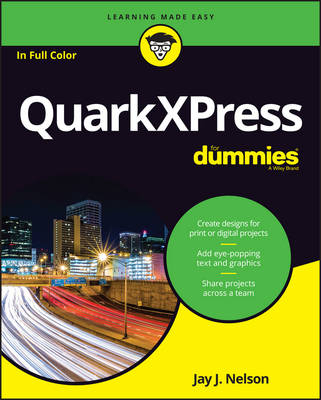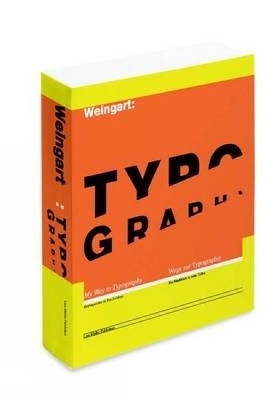
QuarkXPress For Dummies
John Wiley & Sons Inc (Verlag)
978-1-119-28598-4 (ISBN)
- Titel ist leider vergriffen;
keine Neuauflage - Artikel merken
Take the kinks out of working with QuarkXPress QuarkXPress still remains one of the top tools for layout and design projects, even thirty years after it made its debut. This full-color, hands-on guide is here to help you take the guesswork out of using this powerful tool to create stunning print or digital designs. In QuarkXPress For Dummies, you'll find information on the latest changes to QuarkXPress, easy-to-follow, step-by-step guidance on using the tools built into the software to aid in designing and outputting visual product, and quick solutions to common Quark problems when you get stuck. QuarkXPress dominated the page layout world for decades. It's stuck around thanks to how it readily adapts to customer needs. This new version contains updates and features driven solely by customer feedback. That responsiveness is luring new and former users to the fold. That resurgence in the design community has Quark users clamoring for an authoritative book on how to use it to its fullest. Created in partnership with the pros at Quark, this is the book for new and experienced QuarkXPress users looking to make sense of the latest version.
* Offers unbeatable tricks for working with text * Provides guidance on managing larger design projects * Includes tips on how to correct mistakes Take a tour of the palettes, add style to your work, and make QuarkXPress work for you!
Jay J. Nelson is a renowned expert on QuarkXPress, founder of PlanetQuark.com, author of multiple training videos, and QuarkXPress reviewer for Macworld and PC World.
Introduction 1
About This Book 2
Foolish Assumptions 3
Icons Used in This Book 3
Beyond the Book 3
Where to Go from Here 4
Part 1: Getting Started With Quarkxpress 5
Chapter 1: Meeting Quarkxpress 2016 7
Understanding What QuarkXPress Does 8
Getting a Feel for What’s New in QuarkXPress 2016 10
Introducing the Big Features in Recent Versions 11
Managing Your Files 12
Futzing with file formats 13
Opening projects 13
Opening older QuarkXPress projects 14
Understanding and creating a project 15
Closing and saving projects 19
Using Auto Save and Auto Backup 19
Using templates 20
Chapter 2: Getting to Know the Interface 21
Getting a Feel for the Application Interface 22
Surveying the Project Interface 23
Marching through the Menus 24
The QuarkXPress menu 24
The File menu 25
The Edit menu 25
The Style menu 25
The Item menu 25
The Page menu 26
The Layout menu 26
The Table menu 27
The View menu 27
The Utilities menu 27
The Window menu 30
Using Context Menus 30
Mastering Palettes 31
Opening, closing, resizing, and moving palettes 32
Grouping palettes 32
Docking palettes 33
Hiding palettes (Mac only) 33
Using palette sets 33
Searching palettes 34
Organizing with View Sets 34
Visualizing with Output Preview 35
Zooming around Your Layout 36
Using the Pan tool 36
Using the scroll bars 36
Using the Page Up and Page Down keys 37
Using the Zoom tool 37
Zooming (even better) with your keyboard and mouse 37
Moving through pages 39
Using Split Views 39
Splitting a window 40
Removing splits and panes 40
Switching among Layouts 40
Chapter 3: Creating Items 41
Using the Item and Content Tools 42
Creating Boxes 43
Creating Lines and Arrows 45
Creating lines 45
Changing line attributes 45
Building Bézier Boxes and Lines 47
Understanding Bézier shapes 48
Drawing a Bézier box 49
Using the Pen tools 50
Using the magic Freehand Drawing tool 50
Editing Bézier shapes 51
Converting an existing box or line to Bézier 51
Applying Frames, Dashes, and Stripes 52
Creating Text Paths 53
Converting Text to Outlines for Special Effects 55
Using ShapeMaker to Generate Boxes and Lines 56
Creating shapes from scratch 57
Working with shapes found on the Presets tab 59
Converting PDF, EPS, or Adobe Illustrator Files to Native QuarkXPress Items 60
Converting Objects from InDesign, Microsoft Office, and Other Apps to Native QuarkXPress Items 63
Chapter 4: Working with Items 65
Selecting Items 65
Manipulating Items 66
Moving items 66
Resizing and reshaping items 67
Rotating boxes 70
Skewing boxes 70
Flipping box content 72
Locking items 72
Suppressing item output 72
Suppressing picture output 73
Duplicating items 73
Deleting items 74
Using Super Step & Repeat for Super Duplication 75
Cloning Items with Cloner 76
Scaling Items or Layouts, Intelligently 78
Stacking, Grouping, and Aligning Items 80
Stacking items 80
Grouping and ungrouping items 81
Spacing and aligning items 82
Illuminating the Layers Palette 84
Understanding the Layers palette 84
Working faster with the Layers palette menu 86
Changing layer attributes 87
Using layers on master pages 88
Getting Guidance from Rulers and Guides 88
Ruling rulers 88
Getting guide-ance 88
Merging and Splitting Items 93
Finding and Changing Item Attributes 95
Using Item Styles 96
Creating and editing Item Styles 97
Checking Item Style usage 100
Storing Items in Libraries 100
Chapter 5: Building a Layout 103
Making and Using Master Pages 103
Creating an automatic text box 106
Creating an automatic page number 107
Creating a new master page 108
Duplicating a master page 108
Converting a layout page to a master page 108
Deleting a master page 109
Changing the name of a master page 109
Adding new layout pages 109
Deleting layout pages 110
Moving layout pages 110
Applying a different master page to a layout page 111
Changing master page items 111
Modifying Page Size and Margins (If You Dare) 112
Changing page size 112
Changing margins and guides 113
Numbering Pages in Sections 114
Creating a section 114
Changing the starting page number 115
Changing the page numbering style 115
Adding prefixes to page numbers 115
Creating a “Continued on Page . . .” Jump Line 115
Chapter 6: Building a Book 117
Starting a Book 118
Working with Chapters 119
Adding layouts to a book as Chapters 119
Working with Chapters in the Books palette 120
Printing a Chapter or book 123
Exporting a PDF of a Chapter or book 123
Generating a Table of Contents 124
Setting up a list 124
Building a list (collecting the list items into a text box) 126
Rebuilding a list (updating list items in a text box) 127
Creating an Index 128
Using Footnotes and Endnotes 128
Chapter 7: Share and Share Alike: Syncing and Collaborating 129
Sharing and Synchronizing Items 130
Placing shared items and content 132
Unsynchronizing shared items 133
Using Composition Zones 133
Creating a Composition Zones item 133
Placing, styling, and editing a Composition Zones item 136
Unsynchronizing a Composition Zones item 136
Understanding Job Jackets 137
Part 2: Speaking In Text 139
Chapter 8: Creating Text Boxes 141
Understanding Why You Need Text Boxes 141
Deciding Which Is Best: Manual or Automatic? 142
Creating a Text Box Manually 142
Changing the Shape and Appearance of a Text Box 143
Changing the box angle and skew 144
Changing the box corner shape 144
Changing the box color and opacity 145
Adding frames and drop shadows 145
Creating other text box shapes 145
Controlling the Position of Text in Its Box 146
Setting the columns and margins of a text box 146
Vertically aligning the text 146
Setting the inset of a text box 147
Where should the text start? 147
Setting the text angle and skew 148
Linking and Unlinking Text Boxes 148
Linking text boxes 148
Unlinking text boxes 149
Copying linked text boxes 150
Deleting linked text boxes 150
Using Linkster 150
Importing Text 152
Importing text from a word processing document 152
Dragging a text file from the file system 154
Dragging text from another application 154
Exporting Text 155
Chapter 9: Formatting Characters 157
Learning the Basics of Typography 157
Common font formats 159
Font categories 160
Useful font combinations 161
Discovering and Replacing Fonts Used in Your Document 163
Working with font mapping rules 164
Using Font Fallback 166
Choosing to Use the Measurements Palette 167
Selecting a typeface 168
Applying a typeface 168
Choosing a font size 169
Applying and removing a type style 170
Breaking ligatures apart 171
Applying OpenType styles 171
Controlling text spacing 172
Assigning color, shade, and opacity 173
Applying Special Effects 174
Stretching text 174
Converting fractions and prices 174
Using drop shadows for text 176
Inserting Special Characters 176
Inserting hyphens, invisible characters, and automatic page numbers 177
Using the Glyphs palette for other special characters 178
Setting Typographic Preferences 180
Controlling Text Greeking 181
Working with Language Features 182
Choosing a language for spelling and hyphenation 182
Enabling East Asian languages 182
Chapter 10: Formatting Paragraphs 183
Formatting Paragraphs: The Basics 184
Using the text ruler 184
Setting paragraph indents 185
Setting space above and below a paragraph 185
Setting paragraph leading 186
Setting paragraph alignment 186
Setting hyphenation and justification (H&J) 187
Formatting Paragraphs: Getting Fancy 187
Using hanging characters (punctuation) 188
Creating drop caps 188
Keeping paragraphs together 189
Keeping lines together in a paragraph 189
Aligning paragraphs to a grid 190
Adding bullets and numbering 190
Aligning characters of different sizes 191
Adding rules above and below a paragraph 191
Setting tabs 192
Copying Formatting with the Format Painter 193
Styling with Style Sheets 195
Creating a paragraph style sheet 195
Updating style sheets 198
Appending style sheets 199
Deleting and replacing style sheets 199
Applying style sheets 199
Creating a character style sheet 201
Formatting Magic with Conditional Styles 201
Creating a conditional style 202
Using conditional style markers 204
Applying a conditional style 204
Editing a conditional style 204
Removing a conditional style 205
Deleting a conditional style 205
Chapter 11: Editing Text 207
Finding and Changing Text or Attributes 208
Specifying text to find 209
Specifying attributes to find 210
Changing local formats to character style sheets 211
Applying OpenType styles 212
Using the Find and Change buttons 212
Using the Spelling Checker 213
Spell checking a selection, story, or layout 213
Using and managing auxiliary dictionaries 215
Using the Story Editor to Edit Text 216
Using Content Variables 217
Creating and deleting a content variable 217
Inserting, editing, and duplicating a content variable 219
Using a content variable to create a page reference 219
Converting a content variable to text 221
Tracking Changes with Redline 221
Tracking changes 221
Viewing tracked changes 221
Accepting and rejecting changes 223
Using Notes 223
Creating Notes 224
Working with Notes 224
Part 3: Communicating With Graphics 227
Chapter 12: Making Tables 229
Building a Table 230
Using the Table tool 230
Converting text to a table 231
Importing Excel tables and charts 233
Working with Tables 236
Navigating through a table 237
Adding text and pictures to tables 237
Selecting cells, rows, and columns 237
Editing table text 238
Linking table cells 238
Formatting tables 239
Inserting and deleting rows and columns 242
Combining cells 243
Breaking tables automatically 243
Breaking tables manually 243
Adding header and footer rows 245
Converting a table back to text 245
Converting a table to separate items 246
Chapter 13: Adding Pictures 247
Importing a Picture 247
Using ImageGrid to Import a Folder of Pictures 249
Working with Pictures 251
Moving pictures around 251
Cropping pictures 251
Resizing pictures 252
Rotating and skewing pictures 252
Flipping pictures 252
Coloring and shading pictures 253
Adding a Drop Shadow 253
Managing Pictures 255
Finding, updating, and relinking pictures 256
Using Auto Picture Import 256
Editing the original 256
Finding the original 257
Controlling Layers, Channels, and Paths in Photoshop Documents 257
Creating a QR Code in QuarkXPress 258
Exporting Pictures 260
Greeking Picture Previews 260
Suppressing Output of Pictures 261
Chapter 14: When Text Met Graphics 265
Wrapping Text around Other Items 265
Running text around text boxes 266
Running text around pictures 266
Editing a runaround path 268
Running text around lines and text paths 268
Running text around all sides of an item 269
Anchoring Items inside the Text Flow 270
Creating and Configuring Callouts 271
Creating a callout 271
Configuring a callout anchor 272
Working with callout styles 274
Copying and pasting callouts 275
Deleting a callout 275
Chapter 15: Making a Colorful Page 277
Describing Color 277
Specifying Color 278
Creating a new color 279
Using the color picker 280
Applying colors 281
Editing colors 282
Duplicating colors 282
Deleting or replacing colors 282
Appending colors from other projects 282
Knocking out and overprinting 283
Creating Color Blends 284
Adjusting Opacity (Transparency) 286
Adding Colors from Imported Pictures 287
Managing and Proofing Colors 287
Choosing your display profile 287
Soft proofing your layout 288
Creating a custom output setup 289
Sharing color setups 290
Part 4: Getting Ready For Your Big Debut 291
Chapter 16: Prepping to Print 293
Understanding the Print Dialog Box 293
Device pane 295
Pages pane 295
Colors pane 296
Pictures pane 297
Fonts pane 298
Registration Marks pane 298
Bleed pane 298
Transparency pane 299
JDF pane 299
Layers pane 299
Notes and Redline panes 300
Advanced pane 300
Summary pane 300
Buttons 301
Creating an Output Style 302
Working with a Commercial Printer 303
Exporting a press-ready PDF 303
Using Collect for Output 305
Troubleshooting Your Print Results 306
Chapter 17: Going Digital: PDF, Hyperlinks, ePUB, and HTML5 Animations 309
Exporting Pages as Images 310
Exporting to PDF 311
Creating a PDF file 311
Using Interactive PDF Features 313
Exporting hyperlinks and bookmarks to PDF 314
Exporting an entire book to PDF 315
Creating and Editing PDF Output Styles 315
Fixing Common PDF File Problems 317
Font embedding issues 317
Image issues 317
Printer’s marks and bleed 318
Creating Hyperlinks 318
Creating destinations 318
Creating anchors 320
Assigning hyperlink destinations 320
Creating a hyperlink on the fly 320
Editing and appending destinations 321
Formatting hyperlinks 321
Navigating using the Hyperlinks palette 322
Understanding Digital Publishing Formats 322
Creating Projects for ePub, Kindle, HTML5, and App Studio 324
Converting a print layout to a digital layout 324
Creating a digital layout 325
Synchronizing content between orientations 327
Adding Interactivity to Digital Layouts 327
Creating a 360° image 328
Adding animation 330
Adding audio 332
Adding a button 333
Adding a zoomable picture 334
Adding a scroll zone 335
Adding a slide show 337
Adding a video 339
Adding a web view 341
Working with interactivity actions 342
Publishing to ePub and Kindle 343
Exporting to Fixed view format for ePub and Kindle 344
Creating a Reflowable view e-book for ePub and Kindle 344
Creating a table of contents for ePub or Kindle 349
Working with e-book metadata 350
Exporting to Reflowable View ePub 350
Exporting to Reflowable View Kindle 351
Creating HTML5 Publications 352
Part 5: The Part of Tens 353
Chapter 18: Ten QuarkXPress Workflow Resources 355
Quark’s Free QuarkXPress Document Converter 355
App Studio 356
Key Commands for Tools 357
XTensions That Will Blow Your Mind 358
Xdata 358
Xcatalog 358
JoLetter XTension 359
MadeToPrint 359
Image Info XT 359
Arabic XT 359
Badia Software’s XTensions (Mac only) 360
PDF Importer XT 361
ID2Q 361
ID Util (Mac only) 361
AutoCorrectXT 361
Other Affordable Workflow Tools 362
Quite Imposing Plus 362
JoJo (Mac only) 362
AppleScripts (Mac Only) 362
Documentation from Quark 364
The Skinny on QuarkXPress Tips & Tricks 364
Online Resources 364
Planet Quark 365
Quark’s Facebook group 365
QuarkXPress YouTube channel 365
Quark Forums 365
Chapter 19: Ten Do’s and Don’ts When Using QuarkXPress 367
Do Talk with Your Commercial Printer 367
Don’t Use Scroll Bars 368
Do Temporarily Switch to the Item Tool 368
Don’t Copy When You Can Share 368
Do Use the Built-In Calculator 369
Do Make Style Sheets Quickly 369
Do Use Keyboard Shortcuts to Size Pictures and Text 369
Don’t Scale Pictures below the DPI You Need for Output 370
Do Use Auto-Save and Auto-Backup 370
Do Customize How QuarkXPress Works 370
Appendix: Chart of Features Added In Quarkxpress 7 and Up 373
Index 383
| Erscheinungsdatum | 12.01.2017 |
|---|---|
| Verlagsort | New York |
| Sprache | englisch |
| Maße | 189 x 231 mm |
| Gewicht | 674 g |
| Themenwelt | Informatik ► Grafik / Design ► Desktop Publishing / Typographie |
| Informatik ► Office Programme ► Outlook | |
| ISBN-10 | 1-119-28598-4 / 1119285984 |
| ISBN-13 | 978-1-119-28598-4 / 9781119285984 |
| Zustand | Neuware |
| Informationen gemäß Produktsicherheitsverordnung (GPSR) | |
| Haben Sie eine Frage zum Produkt? |
aus dem Bereich


